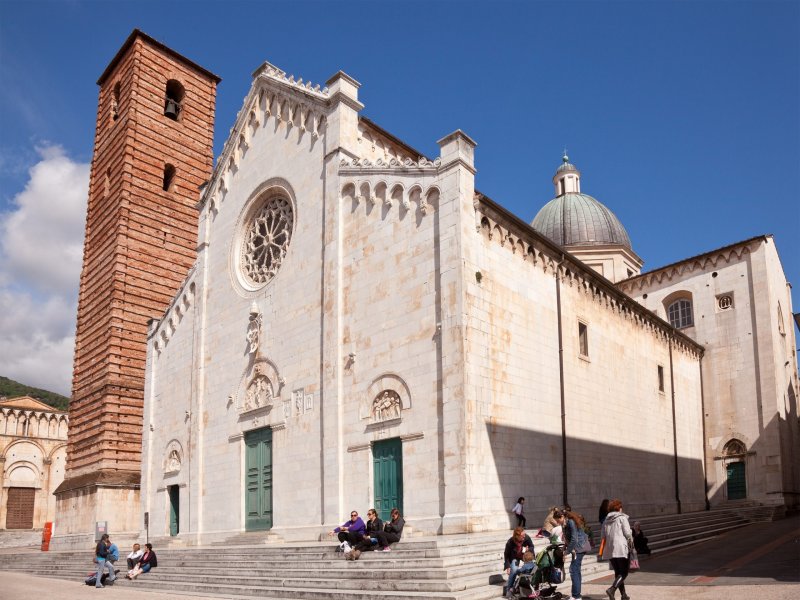
Duomo di Pietrasanta
The exterior is covered in white marble which abounds in the area, with a salient façade, from which the internal profile with the three naves can be glimpsed.
The exterior is covered in white marble which abounds in the area, with a salient façade, from which the internal profile with the three naves can be glimpsed. On each of the three portals there are sculpted lunettes showing as many scenes of the Passion and Resurrection of Christ, generically attributed to the Pisan school. In the right transept there is another door onto Via Garibaldi, also surmounted by a sculpted lunette depicting Saint John the Baptist, a fourteenth-century work by Bonuccio Pardini. The coats of arms on the facade recall the Genoese and Florentine domination of the city, as well as the large coat of arms of Pope Leo Belfry The bell tower that flanks the collegiate church is about 36 meters high, with a square base plan with sides of 8 metres, and has a simple exposed brick surface, even if the original project included a marble cladding, which was never completed. The interior is equipped with a particular helical staircase. The bell tower hosts one of the most prestigious bell concerts in all of Versilia. Manufactured by the historic Lorenzo Lera Foundry of Lammari (Lucca) in 1887, each bell has particular dedications or names. The large bell is dedicated to the Madonna del Sole, the mezzanine to San Martino (owner of the Cathedral), the mezzanella is dedicated to San Costanzo of Perugia and the small one is called Ave Maria (or "Ave Marietta" in common). Very curious is the fact that, when the bells ring out, the bell tower begins to oscillate noticeably due to its entirely brick structure. This elasticity also gives the tower excellent resistance to seismic shocks. The bell tower, commissioned by the collegiate church of San Martino, was finished around 1520 and is attributed to the Florentine architect Donato Benti, but some sources claim that Michelangelo Buonarroti also contributed to its construction, especially in the construction of the complex and characteristic helical staircase. Internal The plan of the church is a classic Latin cross with three naves and transept. The preserved works date back to various eras, but the period that most influenced the current appearance is that linked to the Grand Duchess Christina of Lorraine who, in 1627, commissioned Florentine artists to renovate the church: the side altars were created, which were decorated by large devotional altarpieces (there are works by Matteo Rosselli, Francesco Curradi, Jacopo Vignali, Pietro Dandini, Bastiano Bitozzi, Jacopo Chiavistelli and Alessandro Cominotti), while the sculptural apparatus was curated by Giovan Battista Stagi and Ferdinando Tacca. The marble pulpit, a valuable work by Donato Benti and Lorenzo Stagi (1508) and the two stoups by Stagio Stagi date back to the previous century. The walls and ceilings were painted with various color or chiaroscuro subjects by the Milanese painter Luigi Ademollo between 1823 and 1825. The dome was originally octagonal (1453), but was rebuilt with a circular plan in 1820. In the chapel of the transept to the right of the main altar there is the venerated image of the so-called Madonna of the Sun, a panel painting with a Madonna and Child among saints by an anonymous late Gothic painter, dated 1424 and which is exhibited only during particular celebrations. Pipe organ In 1784, the pipe organ of the oratory of the confraternity of the Santissima Trinità of Pistoia was transferred to the collegiate church, for which it had been built by Domenico Francesco Cacioli together with Antonio and Filippo Tronci between 1748 and 1749; this instrument was in turn sold in 1833 to the parish church of San Michele a Farnocchia and replaced by another specially built by Giosuè Agati; the latter had 48 registers on two manuals and pedal and was enclosed inside a richly ornamented neo-Gothic style case. It was restored by Odoardo Landucci in 1852 and rebuilt by the Agati-Tronci company at the end of the 19th century. The nineteenth-century organ was demolished and replaced in 2017-2018 by a new one built by the Chichi company; the latter has electronic transmission and has 54 registers (three manual and pedal) for a total of 2663 pipes. The instrument is divided into three bodies: the main one is on the choir loft on the counter-façade while the other two are placed behind the main altar and in the space below the right transept.
Share on:
Diventa Redattore!
Vuoi diventare redattore di Pietrasanta.it?
Potrai scrivere articoli sul tuo paese, gli eventi, le manifestazioni etc...
Inviado questa richiesta ci autorizzi a contattarti per maggiori informazioni.
I tuoi dati saranno trattati come previsto dalla privacy.
